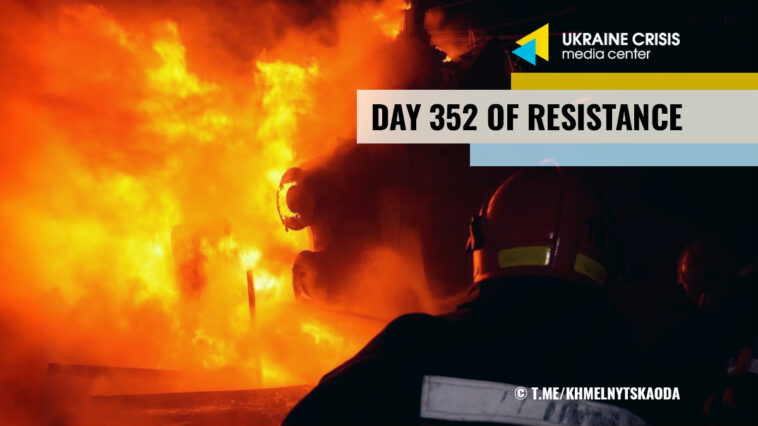Ukraine intercepts 61 of 71 missiles as Russia unleashes fresh strikes across Ukraine
Between the evening of February 9 and the morning of January 10, Russia unleashed a total of 106 missiles of various types on targets across Ukraine. The Ukrainian troops shot down 61 of 71 cruise missiles, Ukrainian Commander-in-Chief Valery Zaluzhnyi said.
“Between 9.50pm February 9 and 12pm February 10, [the Russian forces] fired 71 cruise missiles — of which 43 were of the Kh-101 and Kh-555 types, and 28 were Kalibr missiles; and 35 S-300 missiles. The adversary also launched seven Shahed attack drones. The Ukrainian Armed Forces, together with other units of Ukraine’s defense forces destroyed 61 cruise missiles and five drones,” Commander-in-Chief of the Armed Forces of Ukraine General Valeriy Zaluzhnyi said in a Telegram message on Friday.
The missiles were fired from strategic bombers Tu-95MS flying over the Caspian Sea and Volgodonsk in Rostov region. Some of the cruise missiles were fired from ships in the Black Sea, Zaluzhnyi said.
The Russian forces fired S-300 missiles from Russia’s Belgorod region and an occupied part of Ukraine’s Zaporizhzhia region near Tokmak.
Russia’s attacks on February 9 and 10 mostly targeted power plants and high voltage power lines. The most critical situation is in Kharkiv region where the attacks caused emergency power outages, Ukraine’s national energy company Ukrenergo said.
“[Russian attacks] damaged power facilities in western, eastern, and southern regions of Ukraine. The most critical situation is in Kharkiv region where emergency power shutdowns were applied. There are more limits in the grid in Khmelnytskyi region, and in Odesa and Kyiv regions following the attack,” Ukrenergo said. Russia’s missile attacks caused a major power shortage.
Ukrenergo repair teams are working to restore power supply, the company said.
Ukraine records two Russian missiles flying into Romanian airspace
Two of the missiles that Russia launched against Ukraine on February 10 flew into Romanian and Moldovan airspace, spokesperson for Ukraine’s Air Force Command General Yuriy Ihnat said in a news conference Friday. Ihnat referred to accounts obtained through Ukrainian radar systems. He said he believed more information would emerge from the allies.
“There is data from [Ukrainian] radar systems. Undoubtedly, NATO member countries were watching this situation. I believe that more information would emerge to confirm [Ukraine’s account of the events]. We’ll wait for the information on where the missiles flew. Ukrainian radar systems recorded two Kalibr missiles [flying into Romanian and Moldovan airspace],” Ihnat said.
This is not the first time Russia has violated airspace over other states. It has sent its missiles into Moldova at least three times to strike the western and central regions of Ukraine, Ihnat said. This time, Russia violated airspace of a NATO nation, he added.
Moldovan officials confirmed the violation of their airspace. The Moldovan Defense Ministry said the responsible structures detected, at 10.18 am local time, a missile, which crossed the airspace of the Republic of Moldova, over the town of Mocra in the Transnistrian region and, later, over the town of Cosauți in the Soroca district, heading towards Ukraine.
Romania denied the Ukrainian account, saying that Russian missiles did not enter its airspace.
The shortest distance from Romanian borders the target reached was 35 kilometers, Romania’s Defense Minister Angel Tîlvar said.
Russia prioritizes Kreminna-Svatove area as major axis for offensive
Reports of the Russian command committing new equipment to the Kreminna area, in Luhansk region suggest that the Russian Defense Ministry is prioritizing this axis to begin a major offensive. The Kremlin’s attempt to avoid a wider mobilization of the Russian economy is in discordance with its military ambitions, the Institute for the Study of War said in a report on February 9.
Russian forces continued offensive actions along the Svatove-Kreminna line on February 9. The Ukrainian General Staff reported that Ukrainian troops repelled a Russian attack near Stelmakhivka, 15km west of Svatove. The Russian Ministry of Defense (MoD) claimed that Central Military District elements are operating in the Lyman direction (the area west of Kreminna) and using TOS-1 thermobaric multiple rocket launch systems. The commitment of a military district-level asset such as the TOS-1 to the Kreminna area suggests that the Russian MoD is prioritizing this axis. Widely circulated social media footage posted on February 9 additionally shows a Ukrainian strike on a Russian BMPT Terminator armored fighting vehicle about 8km south of Kreminna, indicating that the Russian command is committing new equipment to this area of the front. The Ukrainian General Staff noted that Ukrainian troops repelled a Russian attack near Bilohorivka. Russian sources (a Russian milblogger) claimed that Russian troops are conducting offensive operations north of Bilohorivka and attacked along the Shepilove-Dibrova line, about 5km south of Kreminna, the report reads.
How Western tanks can make a difference for Ukraine. Ukraine in Flames #337
The German government has approved the delivery of Leopard tanks to Ukraine as part of military warfare aid from the European coalition. Western tanks are likely to make a huge difference in Ukrainian ability to carry out a successful counter-offensive as they can outperform their russian counterparts. Watch Ukraine in flames #337 to find out what military experts are saying about this historical decision and how it can advance the combat capability of the Armed Forces of Ukraine.
Guests:
- Petro Chernyk, colonel, military expert
- Ivan Kyrychevskyi, Defence Express military expert




